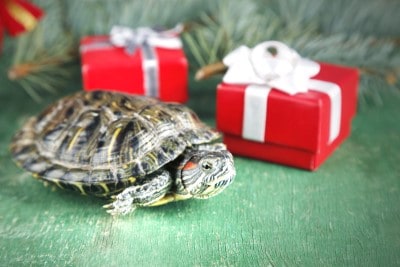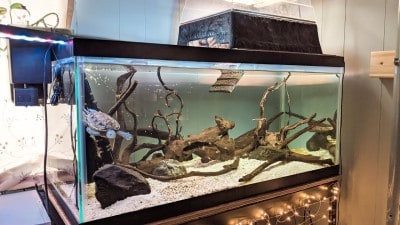Turtles are great animals that make lovely pets for an individual or a family. When you take your turtle home from the pet store, you expect to create great memories with your new pet for many years. However, after having the turtle for a few days, the only thing your turtle keeps doing is trying to escape, and you might be asking yourself why.
The most common reason why your turtle is trying to escape is due to poor living conditions. Other reasons might include stress, hunger, pregnancy, the need to explore, and poor diet. Therefore, before you get a turtle, you need to create a perfect habitat that simulates its natural environment.
As a responsible new turtle owner, your job is to ensure that your turtle is happy and eliminate any factors or things that might make it unhappy. One sign of an unhappy turtle is the constant desire to leave its tank. Keep on reading to find out why your turtle is trying to escape.

Why Is My Turtle Trying To Escape?
A pet turtle trying to escape is a common thing that happens to new turtle owners. Most turtles live inside their tanks for a long time and show no signs of trying to climb out of the tank. If your turtle is trying to escape, you are probably wondering why.
One of the most common reasons why your pet turtle is trying hard to leave its habitat is poor living conditions. Turtles are reptiles, and you need to set the conditions in their habitat right, or else they will try to leave. Some of the poor conditions include too much heat in the basking area, putting your turtle in a small tank, or failing to change the water in the tank. Some of the other things that would make your turtle want to leave might include improper diet, hunger, stress, pregnancy, and boredom. So, let us take a closer look at each of the reasons and how to solve it.
Before you take a turtle home as a pet, you need a tank to keep it because you cannot let it roam free around the house like other pets such as cats or dogs. If you pick a small tank, your turtle will feel a little cramped and try to leave. When you add other accessories into the small tank, your turtle will lack space to move around. It is recommended that you get the biggest tank within your budget limits. If your turtle is between 6 and 8 inches long, get a 55-gallon tank, and if it is more than 8 inches long, you can get a 75-to-125-gallon tank.
Temperature regulation is very important for a turtle, and you need to create an environment inside the tank with the perfect temperature gradient. Turtles are cold-blooded animals, which means that they rely on their surroundings to control their body temperature. If it is too cold or too hot inside the tank, your turtle will try to leave for a better environment. To create a perfect temperature gradient, ensure that the tank is big enough to have a cold side and a hot side. You should install a thermostat in the tank to monitor the temperature in the tank. If you have enough money, you can buy two thermostats and install one on the cool side of the tank and the other one on the hot side of the tank.
You should keep the temperature inside that tank at 70 to 85 degrees Fahrenheit on the wet side and the dry side, it should be 85 to 90 degrees Fahrenheit. You should also ensure that the water temperature inside the tank is perfect. Turtles usually use water to cool down their bodies, and if the water inside the tank is too hot, your turtle will try to find another way to cool down. The water temperature inside your turtle’s water tanks should be kept between 72 and 77 degrees Fahrenheit both during the day and night.
Another reason why your turtle is trying to escape is hunger. If your turtle does not get enough food, it will try to leave its enclosure to find food. As a responsible pet owner, you should ensure that your turtle gets enough food daily. You need to provide your turtle with food at least four or five times for the adults and daily for the juveniles. It is difficult to measure how much food you should give your turtle, but most experts recommend you give your turtle enough food that it can finish within 15 or 20 minutes. You should also avoid overfeeding your turtle because it could lead to your turtle becoming overweight.
Improper diet can also make your turtle want to escape from its habitat. You might be giving your turtle enough food, but it is not something it would eat in the wild. Your turtle will not eat anything you drop in the tank; therefore, you need to find the correct food for your turtle. When you go to the pet store to buy food for your turtle, you should ensure that you buy the food meant for your turtle’s species. You should also ensure that you provide your turtle with a balanced diet. If your turtle keeps getting the same type of food every day, it will try to escape the tank to find other things to eat.
Turtles can get stressed very easily, and they will try to leave the tank, especially when the element causing them stress is inside the tank. For example, if the tank does not have a hiding spot, your turtle will feel overexposed because they cannot find a place to hide when they are scared. Other things that can cause stress include excessive noise, poor handling, and overcrowding.
Therefore, ensure that the tank has enough hides for the turtle to feel secure. You should also keep the tank in a quiet place. Do not house many turtles in one tank. If you want to figure out if something is stressing the turtle, put yourself in its place. If the situation bothers you, it probably bothers and stresses your turtle.
Pregnancy can also cause your turtle to try to leave the tank. In the wild, turtles usually lay their eggs on holes they dig in the grounds and cover with dirt and leaves. When your turtle wants to lay eggs, it might start behaving strangely, like stop eating, basking, and digging everywhere in the tank’s substrate. Since the tank has water in it, the turtle would not want to lay eggs near it; hence, it will try to escape to find a better place to lay eggs.
If you have confirmed that your turtle wants to lay eggs, you can either take it outside and let it lay eggs in the yards or prepare a place to lay eggs indoors. If you do not have a yard, you can place organic potting soil and sand inside a large plastic container and put your turtle in it every day until it stops laying eggs.
Boredom can also cause your turtle to want to escape from its tank. In the wild, turtles have the freedom to move to any place they want, but when you keep them in a tank, their movements may become restricted. Turtles need to explore their environment in search of food, shelter, and mates. The conditions in the tank might be perfect, but your turtle might be bored of staying in the same place for a long time.
If you have a backyard, you can take your turtle out of the tank and let it move freely in the yard. You should never leave the turtle unsupervised. Ensure that your backyard is secure. If you do not have a backyard, you can let your turtle move around the living room for some time.
Lastly
You should not be worried because your turtle is trying to escape, but it should be a warning for you to improve the living standards of your turtle. Through this article, you now know what might cause your turtle to try and escape and how to fix the problem. However, if you try fixing all the issues and your turtle still wants to escape, you should take it to a vet. If the tank is perfect, the environment inside the tank is conducive, and your turtle gets a balanced diet, but if your turtle still wants to leave the tank, it could be sick. Taking your turtle to a vet could be the only way to know what is truly wrong with your turtle.
Read more:








